INDUSTRIAL &
TERMINAL RAILROADS &
RAIL-MARINE OPERATIONS
OF BROOKLYN, QUEENS, STATEN
ISLAND, BRONX &
MANHATTAN:
LV Harlem River
| BRONX TERMINAL
/ EAST 149TH STREET Mott Haven, the Bronx, NY LEHIGH VALLEY RAILROAD |
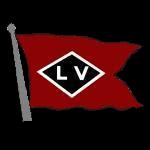 |
.
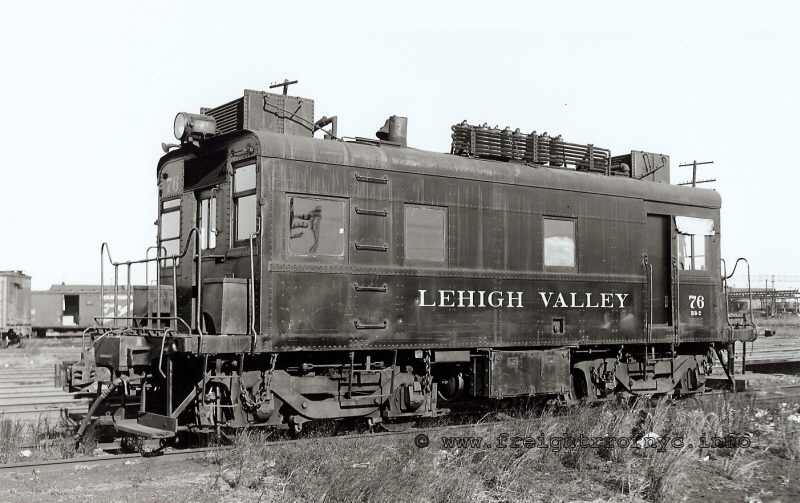
Special Thanks to Ralph A. Heiss and David Pearce.
The majority of information on this webpage is either
discerned or used in part from their Transfer #42 feature article
as published by the Rail Marine Information Group.
.
|
updated: |
||
|
|
||
|
update summary: |
date: | chapter: |
| photo of #125 added |
01 January 2023 | Locomotive Photos |
.
.

| Lehigh Bronx Terminal Warehouse | Customers & Commodities | ||
| Locomotive Photos | Locomotive Roster builders data, previous owners & disposition info |
||
| Marine Equipment |
|
Memorabilia |
.
.
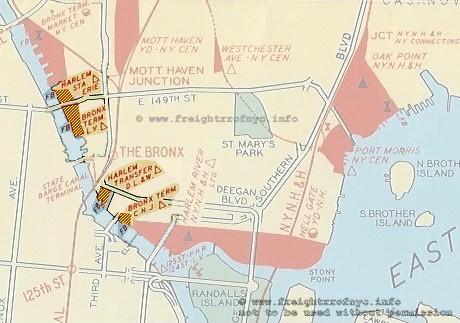
Port of New York Authority
New York Harbor Terminals, July 1943
.
.
The Lehigh Valley Railroad Bronx Terminal was located on the Harlem River as were the three other Harlem River offline terminals. This property was located on the south side of East 149th Street and west of River Avenue.
This facility opened late 1906 - early 1907.
This facility would undergo a major site reconstruction in 1926.
Just across East 149th Street to the north was the Erie Railroad Harlem Station which is discussed on another page on this website.
The Lehigh Valley Railroad Bronx Terminal closed this facility in 1968, and the property was sold in 1969.
.
According to Ralph Heiss & Dave Pearce research and their article appearing in the Rail Marine Group publication Transfer issue #42; a Board of Director's meeting of the Lehigh Valley Railroad on September 12, 1905, determined a necessity in establishing a freight terminal in the borough of Bronx.
Within a mere two weeks of this meeting, approximately four and a half acres of land would be purchased in the Mott Haven neighborhood of the Bronx. This land was directly on the Harlem River an afforded the use of that waterway.
Contracts for construction of the Bronx Terminal were solicited in early 1906 and approximately a year later, the Lehigh Valley Railroad announced completion of their "East 149th Street Bronx Terminal".
If that date is accurate, than this terminal would be the second offline freight terminal with carfloating to open in the Bronx, being preceded only by the Harlem Transfer facility which opened in 1898 and was purchased outright by the Delaware, Lackawanna & Western Railroad in 1906.
|
|
The designer of the Lehigh Valley Railroad's Bronx Terminal
property was Walter G. Berg, who was the assistant engineer (and eventually
chief engineer by 1906); of the Lehigh Valley Railroad.
One might note the similarities between this facility and the Delaware, Lackawanna & Western Railroad's Harlem Transfer facility, just a ¼ mile south on the Harlem River. This is not coincidental as Walter Berg designed both facilities. The Bronx Terminal, like it's "cousin", the Harlem Transfer; would feature a semi-circular freight house served by concentric loops of trackage. In the Lehigh Valley Railroad's Annual Report of 1910, a travelling electric gantry crane of 30 ton capacity was installed, replacing a fixed overhead gantry of lower lifting capacity, installed when the Bronx Terminal was first constructed a few prior. The new gantry can be seen in the image below. My apologies for the quality of the image, and I hope to secure a clearer image in the near future. |

Lehigh Valley Bronx Terminal - 30 ton capacity traveling
gantry - undated photo (ca. 1929)
"Warehousing in New York City" - Lehigh Valley Railroad Brochure
authors collection
added 3` Oct
2009
.
A new warehouse was constructed in the northeast corner of the yard, and was subsequently leased to George A Zabriskie, a flour wholesaler. Sidings at this juncture in time for the storage of freight cars was minimal, with overall capacity being twenty-seven freight cars.
From the 1911 track map above, a siding is proposed to run along Exterior Street, presumably to service American Radiator.
One siding served a hay shed, and a double track siding served the overhead gantry and the George Zabriskie flour wholesaler.
According to Lehigh Valley Railroad Board of Director's minutes of July 24, 1911, this lease was to last until June 30, 1916, but maps and photographs shows a sign showing Pillsbury Flour on this structure.
This structure is noted to have been slightly crescent shaped with a curved siding (see aerial image below). Another Annual Report of the Lehigh Valley Railroad for 1921, reflects additional yard trackage installed.
The following image, a G. W. Bromley property map from 1928 already reflects some minor changes. This map, like most property maps, should not be relied upon to be accurate for the track layout.

G. W. Bromley -1928
..
.
According to the legend on the Bromley map index, pink structures denote brick construction, yellow structures are wood frame construction, stone / concrete construction in light brown, and wood frame with brick front represented by a yellow with pink outline.
I have included these construction types to give the reader a better sense of the many types of structure compositions that existed in these freight terminals.The following image, a Fairchild Aerial Survey Photo dated 1924, better shows the original configuration of the property, prior to the reconstruction changes that would take place, two years hence. An auto unloading platform was constructed along the inner loop of the of concentric track structure, in the open courtyard. (Three boxcars can be seen at this platform in the aerial photo below.)
The Hay Shed is also plainly visible as the square building with shallow peaked roof to the left of the semi-circular freight house.
Take note of the unimproved property south of the American Radiator building below the semi-circular freight house. This open area will pave the way for the expansion in two years.
.
Fairchild Aerial Survey Photo - 1924
NYPL archives
.
Reconstruction & Expansion - 1926
A major site renovation and reconfiguration took place following a Lehigh Valley Railroad Board of Director's Meeting on July 13, 1926. A mortgage was issued for adjoining property south of the established terminal property, adding another six acres of land and longer Harlem River frontage.
Brad Sobel sent a scan of this blueprint. This blueprint, (which predates his family's presence at the Bronx Terminal), is the proposed structure and tracks for the Pillsbury Flour Mills dated November 19, 1926.
Note the lunch wagon on the corner of East 149th Street and Exterior Street!

added 05 March
2009
.
As part of this reconstruction and expansion, the land south of East 146th Street was filled in, graded and a new team yard increased the Bronx Terminal's car capacity from 27 to 171. A significant increase!
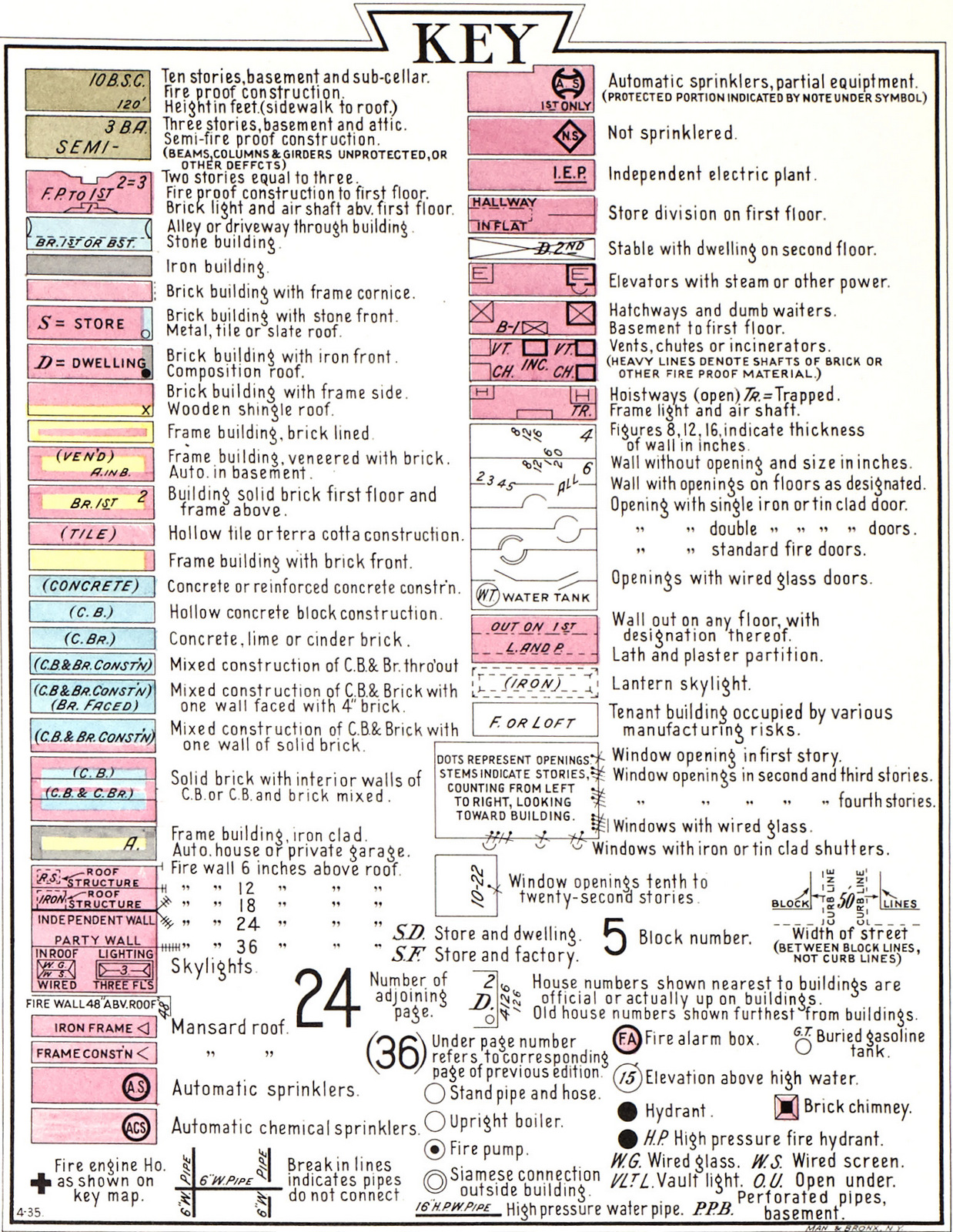 |
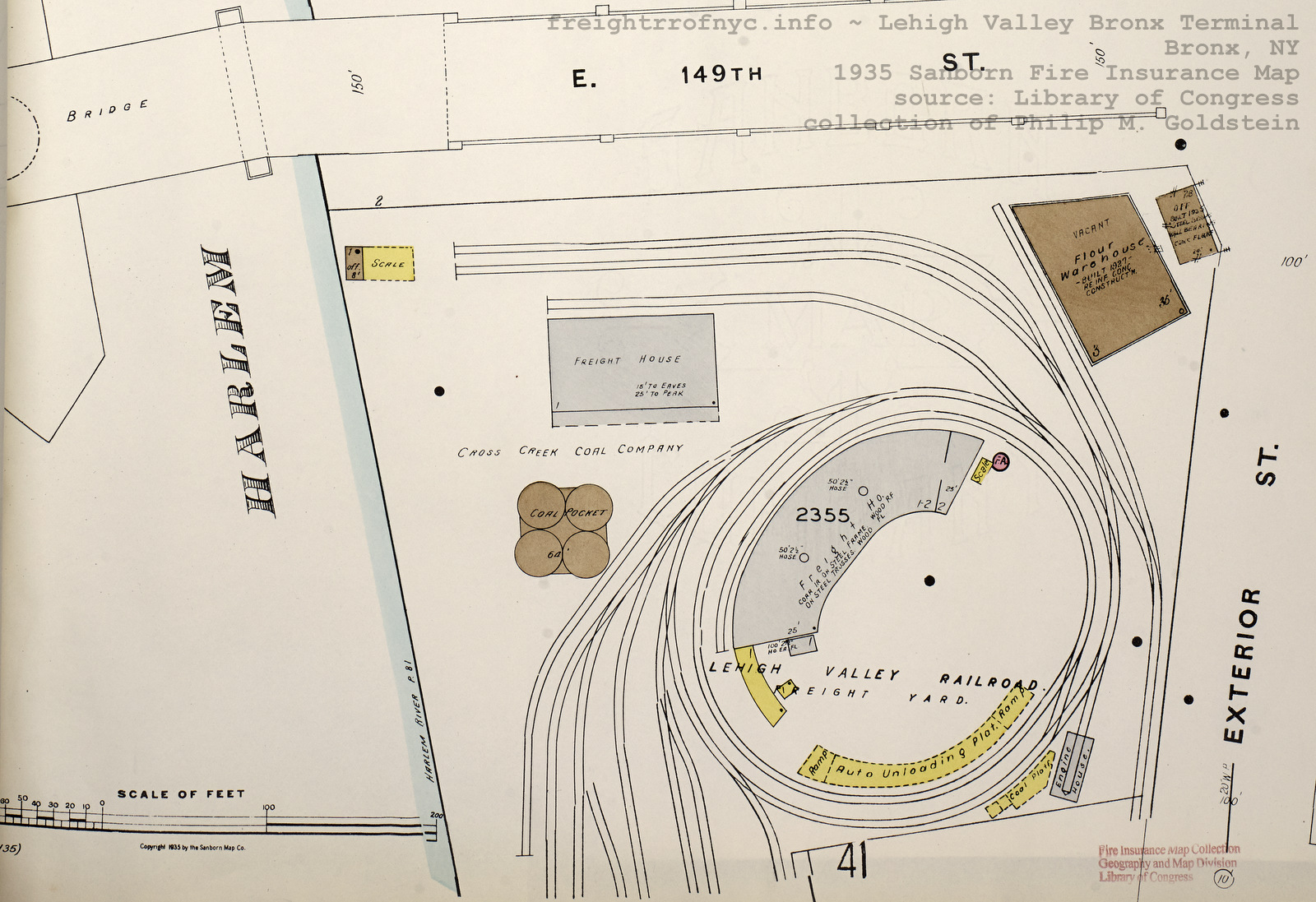 . . . . |
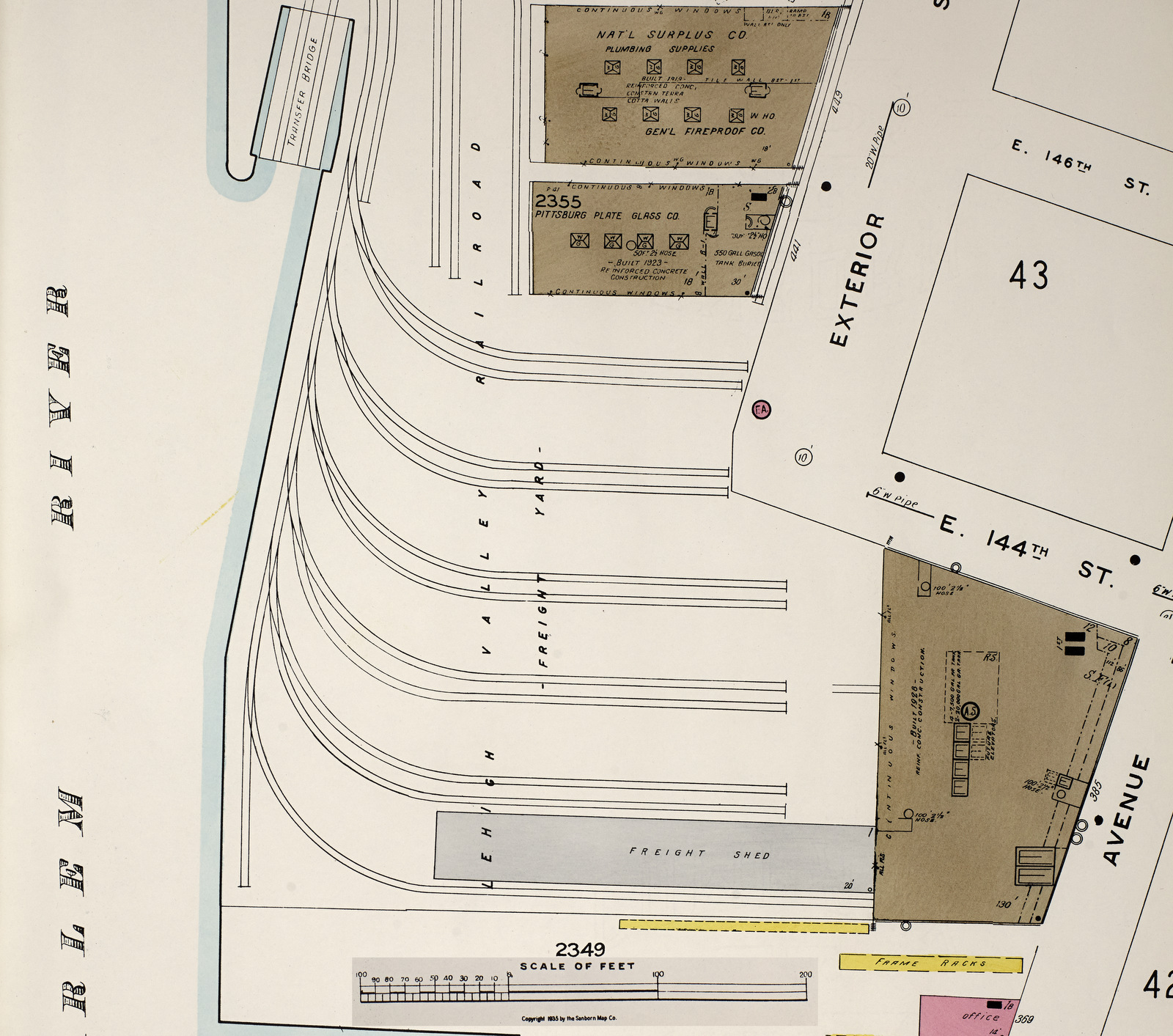 |
|
| Sanborn Fire Insurance Map - 1935 Library of Congress authors collection added 01 January 2023 |
|
| . . |
. . |
.
..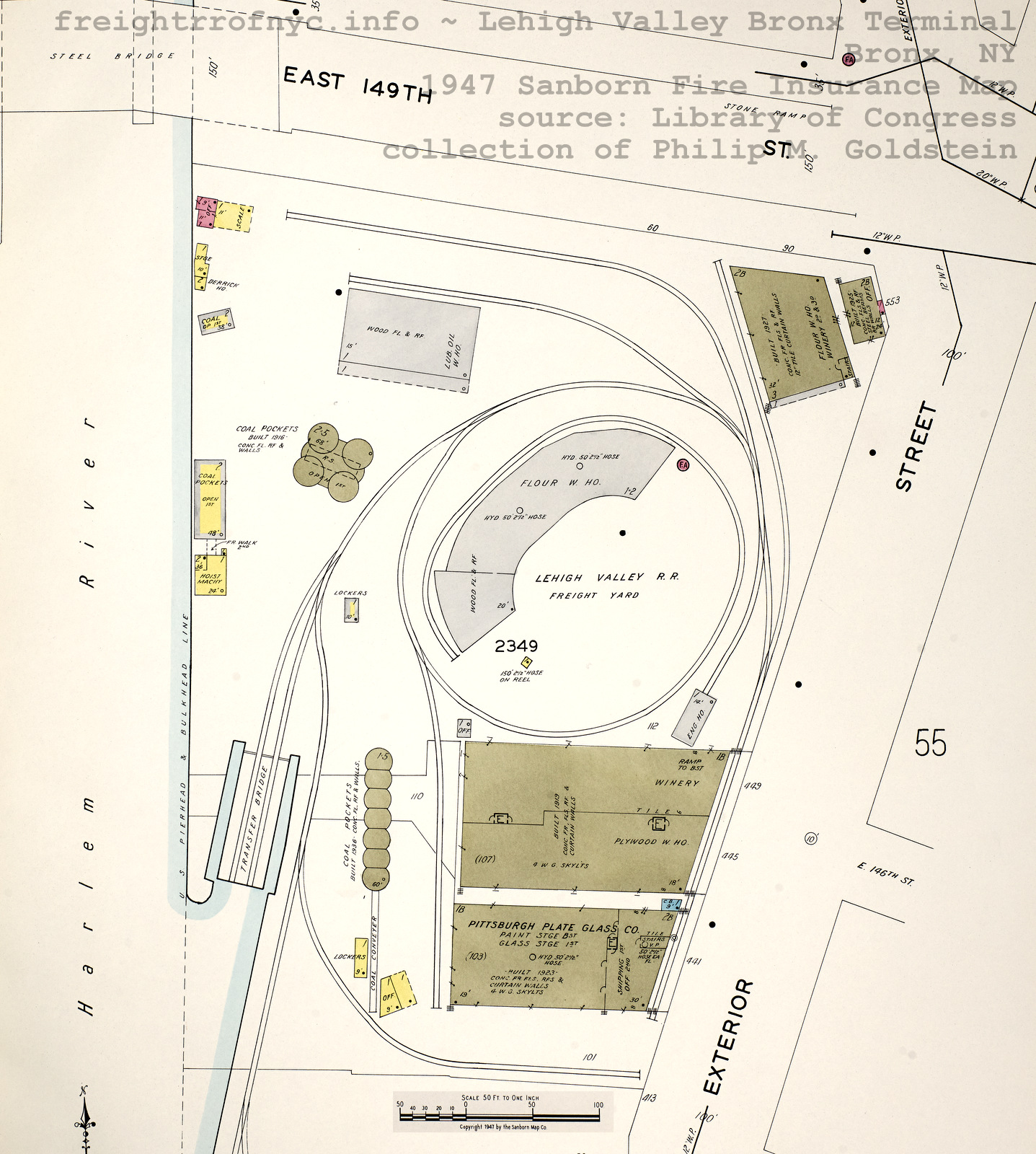 |
|
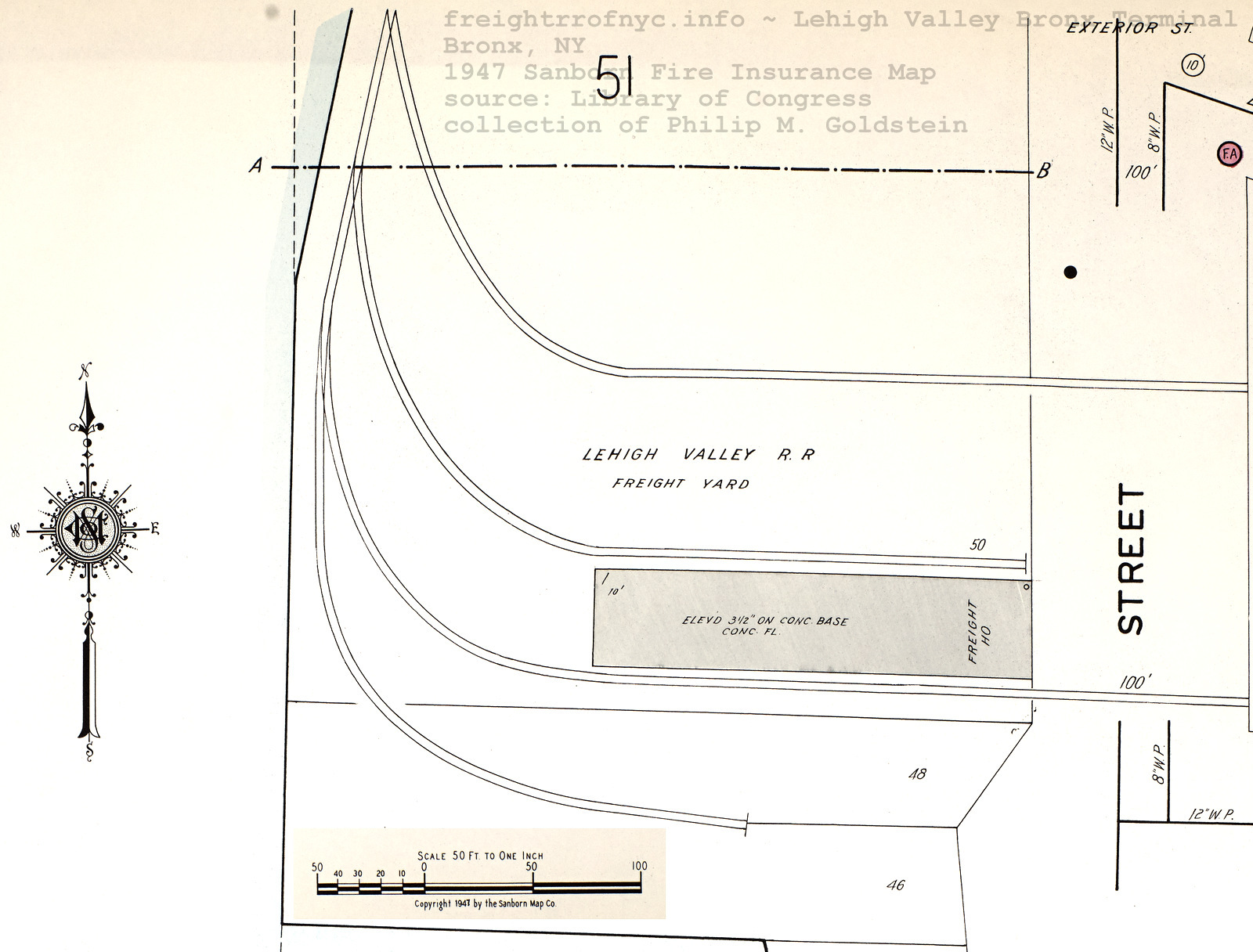 |
|
| Sanborn Fire Insurance Map - 1947 Library of Congress authors collection added 01 January 2023 |
|
| .. . . |
|
.
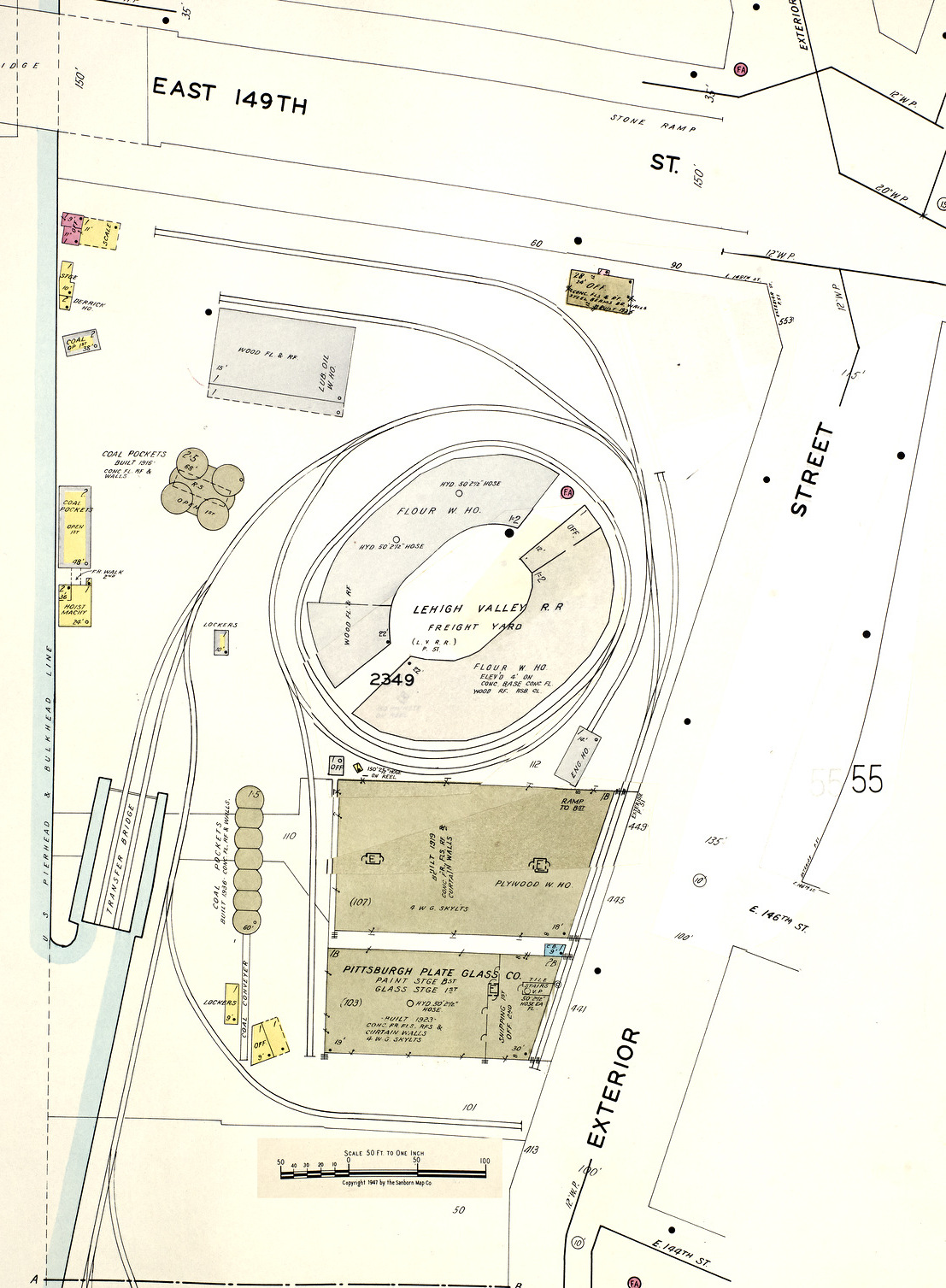 |
|
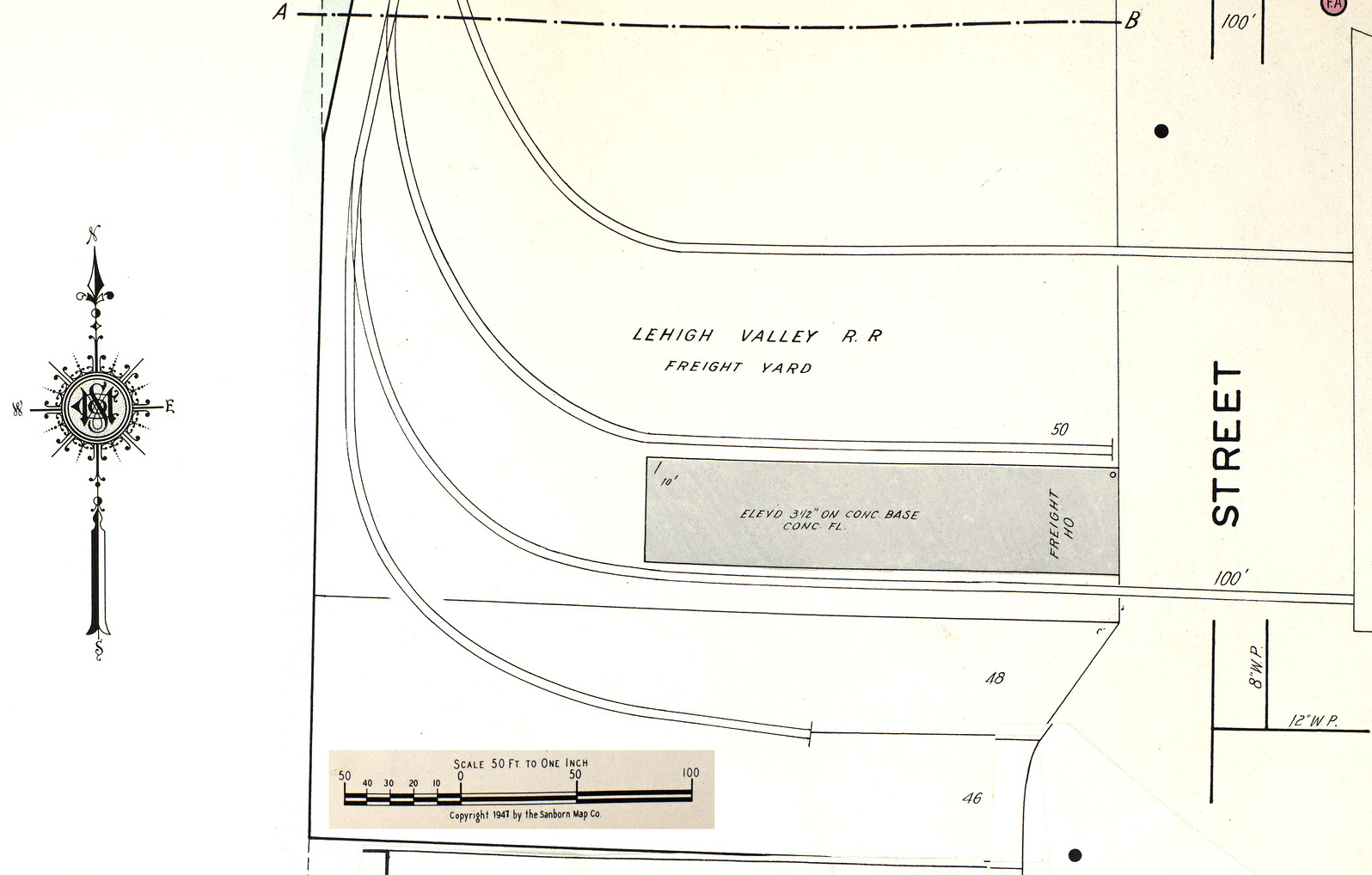
|
|
| Sanborn Fire Insurance Map - 1951 Library of Congress authors collection added 01 January 2023 |
|
.
Lehigh Bronx Terminal
Warehouse

"Warehousing in New York City"
Lehigh Valley Railroad Brochure - ca.1929
authors collection
added 31 October
2009
.
.
| A significant addition to the
"new" southern property of the Bronx Terminal was a new twelve story fireproof
warehouse with covered transfer platform.
This structure was built on the corner of Gerard Avenue & East 144th Street. This new structure, constructed and ready for occupancy on May 1, 1929 was called the "Bronx - Lehigh Terminal Warehouse". This structure was 227 feet by 147 feet, with the following square footage per floor:
Ceiling heights for floors 2 through 12 were 11 feet 10 inches. This warehouse was designed with automobile storage in consideration, and floor support columns were spaced accordingly. On street level, a loading dock 3'6" high was incorporated into the design allowing trucks to back up to the building to transfer freight. As constructed, there was one passenger and six freight elevators, two of which were sufficiently sized at 10 feet by 20 feet and of 8000 pound load capacity to transport full size automobiles from floor to floor. Furthermore, a 220 foot by 43 foot shed was built for the storage of automobiles (shown as covered platform). Truck deliveries were made on the ground floor with an entrance from East 144th Street. The ground floor was also served by trackage from the yard. A heated sprinkler system and "fireproof" construction ensured low insurance rates. Rental rates for the warehouse varied from .5163 cents per square foot (9th & 10th floors, and for full floor occupancy), to .70 cents per square foot (2nd floor), with rates depending on floor, rental space (full or half floor) and location (northern half or southern half). The complete brochure, cover to cover; may be viewed in the Memorabilia Chapter below. |
|
A car unloading platform would be constructed just north of the float bridge as well, with yet another automobile unloading ramp and flour shed constructed towards the northwest corner of the property, where the former carfloat slip and float bridge were located, which had been filled in upon reconstruction. Keep in mind during this time period, automobiles were shipped in "double door" boxcars, and not "open auto racks" of the type commonly used in the mid-to-late Twentieth Century.
The G. Zabriskie / Pillsbury Flour structure appears to have been rebuilt as well, as it is now trapezoidal in shape with a straight siding. A new "10 Year" lease dated 1926 is noted for this occupant..
|
. |
In February 1930, a lease agreement with the Cross Creek
Coal Company was signed for parcels on the property. That company built
two separate coal storage & handling structures.
The first structure, a "four pack" or 2 by 2 arrangement of concrete coal silos with a total capacity of 150 tons, was constructed on the site of the former hay shed, (almost directly in front of the new float bridge). The second structure was an inline group of seven concrete silos holding a total of 700 tons of coal. This structure's location required the removal of two team tracks. A covered conveyor belt was located on the south end of the silos that led to a "between the track" hopper basin. The coal hopper would be spotted over this basin, and the hopper dorr would be opened, coal would fall into the basin and be transported up the conveyor into the silos. In the 1936 image below, both sets of the coal silos can be seen, with the edge of the float bridge and a carfloat on the extreme left edge of the photo. This name Cross Creek Coal is a source of minor deliberation, as these coal silos would bear the names of Streat (as seen in the 1936 photo below) and in later years Stokes through the later life of the terminal, yet Cross Creek appears on the track maps. The Pillsbury Flour Company would cancel their lease on April 24, 1936; however a new ten year lease was agreed upon by the Bronx Flour Warehouse on the same day. In 1938, the City of New York sought to condemn approximately half an acre of the terminal property for the purpose of of extending Exterior Street further south to Gerard Avenue. This required the Lehigh Valley Railroad to shorten the team tracks in front on the Bronx Warehouse thereby reducing freight car storage capacity of the team yard and shorten the automobile storage shed. The Railroad received a little over ninety thousand dollars in compensation, but now now required the Lehigh Valley Railroad to cross a city street to continue to access Bronx - Lehigh Warehouse. For a railroad to transverse a street in the City of New York, it requires a "Certificate of Convenience & Necessity" of which was renewable on an annual basis. The Lehigh Valley Railroad eventually reached settlement with the City of New York for damages inflicted from the Exterior Street extension, and the railroad would be allowed to cross the thoroughfare. In later years however, the City would charge the Lehigh Valley Railroad $1,000 per year for this street crossing convenience. (Somehow, they always get you in the end!)
|
| Also in 1938; Silver Flour requested a new bay be constructed to the south wall of the semi-circular Bronx Terminal warehouse, which required a revised concentric track structure around the freight house. The original inner loop track would be "dead ended" against the wall of the new addition. | |
|
. |
|
|
The image seen to the right, is a G. W. Bromley Property Map, 1942 edition. When compared to the 1928 edition above, we see that the floatbridge orientation has been changed from east / west (or perpendicular to the Harlem River), to north / south (or parallel to the Harlem River). This map, like most property maps; shows the residents of significant structures. The Lehigh Valley Bronx Terminal served the Streat Coal Company. The reconfiguration increased the property footprint by also filling in the southern basin, and adding a yard to the south. Constructed at the new southern yard was a covered platform which was located between the southernmost two tracks and the Pittsburgh Plate Glass Company. The image directly below, is an Army Corp of Engineer Port Series Map, circa 1954 or 1965, shows the track layout unchanged, but Streat Coal is now Stokes Coal & Oil Company.
|
|
A minor (albeit administratively) change and a moderate (structural) change to the property came about in 1944.
The Lehigh Valley Railroad sold off their Bronx - Lehigh Terminal Warehouse (along with the Starrett - Lehigh Building in Manhattan). The structural change occurred when the City of New York (them again!?!?) decided to bring condemnation proceedings against the Lehigh Valley Railroad to raze the structure built for the Pillsbury Flour Mills and an office structure of the Cross Creek Coal Company, both of which were located on the northeast corner of the Bronx Terminal property.
This "condemnation" (I believe the modern day "buzzword" for this legal maneuver is "eminent domain"), was essentially brought about by the impending construction of the Major Deegan Expressway. The Major Deegan Expressway, so named for William Francis Deegan (December 28, 1882 – April 3, 1932); who was a Major in the Army Corps of Engineers and was a Democratic Party leader in New York City.
The Expressway is a limited access elevated highway built over Exterior Street, connecting the Triborough Bridge with the New York State Thruway and similar in application but not in design, to the West Side Highway which was located in Manhattan. It seems as if anywhere the Lehigh Valley Railroad had put a Freight Terminal in New York City, someone eventually wanted to build a elevated highway over it!
Anyhow, the City of New York would get their way (again... Don't you know you can't fight City Hall!), and a new three story brick office building would be constructed for Cross Creek Coal slightly west of the original, and the Deegan Expressway would eventually open in 1956.
In 1947 the last significant change to the Bronx Terminal property took place. A second crescent shaped freight house would be constructed on the court yard opposite the original and where the auto unloading platform once stood. This new construction formed the commonly recognized "parenthesis" appearance: ( ).
The new freight house was considered fireproof as well, being steel framed and sheathed in "Transite", an asbestos impregnated cement fiber board. (Asbestos is fine if you don't tamper with it - so no terse thoughts or comments about mesothelioma!)
Fortunately, Paul Strubeck located a 1957 Fairchild Aerial Survey Map of the terminal in the New York State Library Digital Archives Collection. This image will be able to give us an extremely close approximation of the final layout and structure configuration of the Bronx Terminal. Click on the back arrow on your browser to return you here.
.
.
Other than those names of the property lessees listed on the G. W. Bromley maps, not much is known about the other customers.
Known tenants and customers comprised of the following:
| George A. Zabriskie | flour |
| Pillsbury Flour Mills | flour |
| Cross Creek Coal | coal |
| Stokes Coal | coal |
| Streat Coal | coal |
| Silver Flour Warehouse | flour |
| Pittsburgh Plate Glass | glass |
| United Plumbers Supply | pipe? |
| American Radiator | cast iron radiators? |
| Central Foundry | metal |
| Morton Salt | salt |
| US Playing Card | playing cards |
| Krasdale | grocers |
| hay | |
| American Bread Wrapper | paper? cellophane? |
This facility handled general freight consignments both inbound and outbound through the freight house, but judging from the photos, this facilities primary inbound commodity was obviously coal. One only has to look at the 1957 Fairchild Aerial Photo above to see the amount of "black diamonds" on site.
However, this author was fortunate to have been contacted by Brad Sobel, of whom his family was a property lessee from the Lehigh Valley for a good portion of the Lehigh Valley Railroad's presence in the Bronx::
"My family's business was Silver Flour Warehouse and Trucking Corp.
We leased warehouse space at the 149th Street Yard starting in 1932 and ended in April of 1968. From there we moved to the New York Dock Railroad, Atlantic Terminal.
I have blue prints dating from 1926 for 149th Street. I myself have many fond memories of the Bronx yard. In looking at your blue print for 149th Street you are missing one warehouse, in area 112. Those were the two warehouses we occupied along with the LVRR's office in the one that is not being shown.
I am not sure, but it is a possibility that we worked out of area 107 from 1926 according to a lease dated 1946. I have other leases from 1930 for the 124th Street Yard, NYC and Pier G, Jersey City, New Jersey."
Brad was gracious enough to send scans of the lease agreements between Lehigh Valley Railroad and his family firm of Silver Flour.
Contained within these documents, are the arrangements Silver Flour made with the Lehigh Valley Railroad when the City of New York began condemnation proceedings for a portion of the property for the anticipated Major Deegan Expressway.
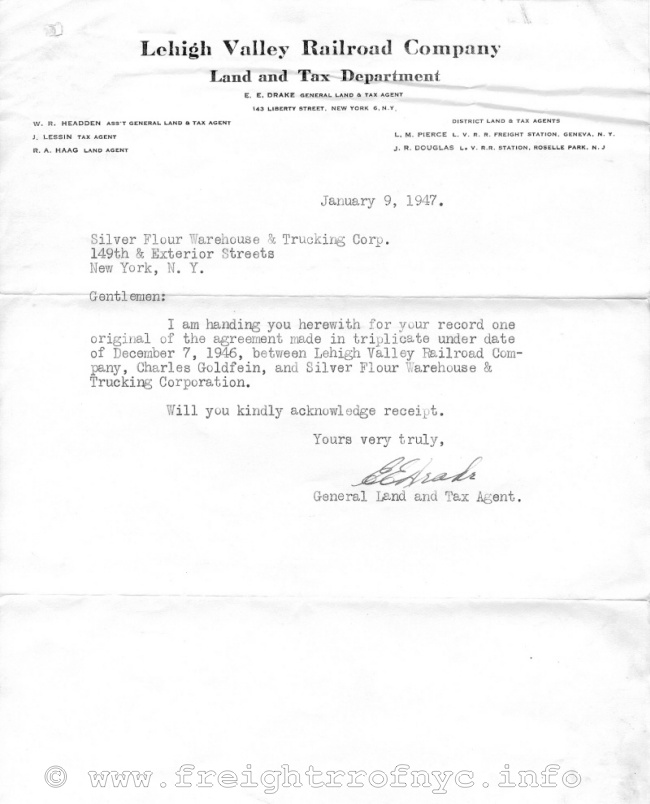 |
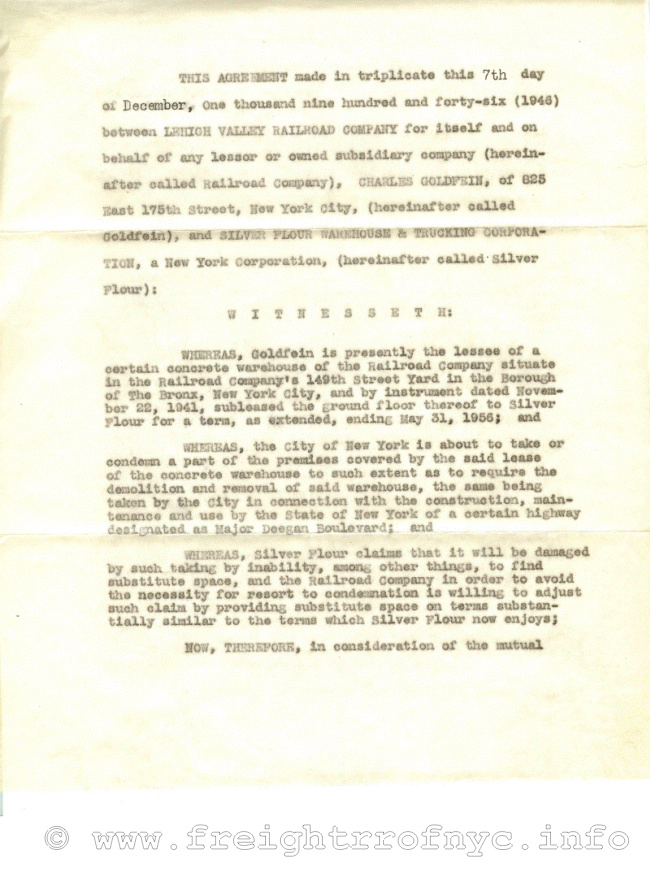 |
|
|
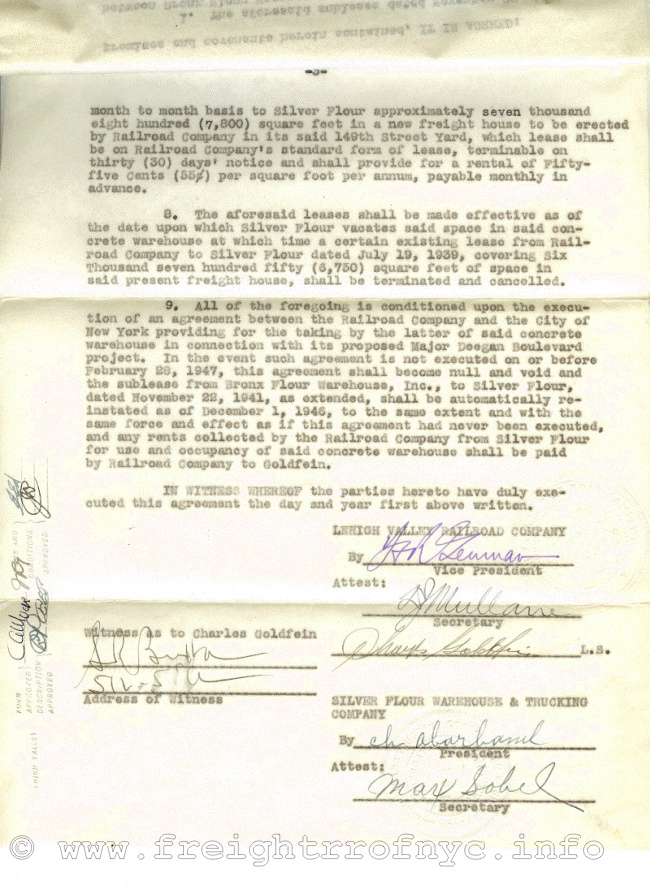 |
|
. .
|
.
The Lehigh Valley Bronx Terminal would use a wood Howe Truss float bridge both prior to the 1926 reconfiguration as well as after. It is believed this is the same float bridge, just relocated upon the site reconstruction.
It is unknown if this float bridge was ever replaced with a steel design, but it seems unlikely.
With the original property layout (before the 1926 reconstruction), Lehigh Valley Railroad was required to use short carfloats to minimize navigational obstruction of the river, due to the perpendicular (east - west) orientation of the float bridge to the Harlem River.
This meant that when a carfloat was "bridged" (attached to the float bridge), the carfloat would be jutting out into the Harlem River, and presented an obstacle to marine traffic. The shorter the carfloat, the less on an impediment to river traffic.
This dictum changed upon the 1926 reconstruction of the property and reorientation of the float bridge to nearly parallel (north - south) to the Harlem River.

May 1929
(north is right)
RMIG Transfer 42, R Heiss / D. Pearce
article
added 13 May
2009
.
This new float bridge orientation would allow standard length carfloats (300-325 feet in length) to be used, and reduce interference to river traffic to practically nil. Not to mention this new float bridge orientation made it easier for the marine crews in landing and mooring carfloats.
Personal accounts related to Ralph Heiss from Ben Wilczweski (via his son Fred), who was a Lehigh Valley Railroad employee starting in 1937 and would be assigned to the Bronx Terminal in later years.
Towards the end of operations of the Lehigh Valley Railroad, a loaded carfloat sunk at the foot of the Bronx Terminal float bridge. Being financially strapped, the railroad considered abandoning the carfloat in place. However the US Coast Guard had other ideas about the sunken carfloat being a navigation hazard, and ordered its removal.
Also, the pontoon on the float bridge, developed some rather large leaks and was exceeding the capacity of the pumps employed to pump the water out of the pontoon. Therefore, Lehigh Valley Railroad removed the pontoon from under their "6 Bridge" in Jersey City and "transplanted" it under the Bronx Terminal float bridge.
.
Very little in the way of records is known for locomotives operating at the Bronx Terminal of Lehigh Valley Railroad. Much of the information for locomotives that were used at the Lehigh Valley Bronx Terminal, is compiled when a photograph surfaces denoting the location as East 149th Street or Bronx Terminal or when information is submitted by way of another historian (i.e. Ralph Heiss).
.
#3500
This author, in the process of searching the internet for Lehigh Valley steam switching locomotives, came across an image of an 0-4-0T. This photo of #3500 appears to have been taken streetside with the possibility of also being dockside. Unfortunately, the location or the date taken of this photograph is not denoted.
This in turn, led to an in-depth search of various builders records in the author's possession, for Lehigh Valley steam locomotives of 0-4-0 or 0-6-0 wheel arrangements. Surprisingly, this search revealed very few switching locomotives of that wheel arrangement and of side or saddletank type. Matter of fact, this locomotive is only one of two 0-4-0 or 0-6-0 saddletank type locomotives owned by the Lehigh Valley Railroad, that the author has been able to locate so far.
However, #3500 being a 0-4-0T, is most suitable for use at the Bronx Terminal location, and the photo below appears to have certain elements that would be seen at a street and waterside terminal. In the image below, take note of the lamp post on what appears to be a dock or wharf, with what appears to be a basin of water behind the handrail and behind the locomotive.
I have attempted to contact the owner of the photo of #3500 (Railway Excess Agency), but my emails are getting returned as undeliverable. The owner has listed the image as believed to be out of copyright, so I have posted that image in the roster below. On the off chance that the owner finds this webpage and sees that image, please contact me at bedt14@aol.com.
As of 4/8/2021, and thanks to a photo courteously provided by Guy Fluck, we can now confirm that 3500 was indeed assigned to the Bronx Terminal. That photo may be seen below.
Builders information for #3500 appears in the roster below.
Pursuant to the initial ratification of the Kaufman Act, this facility would see the acquisition of one of the new A/GE/IR boxcabs developed to allow the railroad to comply with the act.
You can read the comprehensive history of all steam locomotive restrictions for the City of New York, beginning 1834 and ending with the Kaufman Act and its repeal on the main page of this website: Steam Locomotive Regulations within the City of New York. It is very much worth a read, because there are misconceptions about the Kaufman Act, i.e. such as it was repealed in 1930.
.
#110 / #50
On 27 March 2009; this author located on eBay an image of Lehigh Valley #50, a Mack switcher. Initial interest in looking any further at the lot, was that that it was of Mack build, similar to the Pouch Terminal Mack switcher. Upon reading the the actual item description however, it was learned that the photo was taken at the East 149th Street Terminal in the Bronx!
This discovery now adds this locomotive to the roster of Lehigh Valley Bronx Terminal locomotives. According to Mack builders records, this locomotive was originally Lehigh Valley #110 and was built in December 1929. Actually, there were two identical locomotives of this type built for the Lehigh Valley Railroad: #110 (renumbered #50) and #111 (renumbered #51).
Both were Model AY: 45 ton gas - electrics, three axles (6 wheel) and powered by three Mack 6 cylinder gasoline engines developing 405 horsepower. This Model AY was somewhat larger than that of the Pouch Terminal Model AW switcher, which was a two axle model, and it is unknown if #111 / #51 was used at the Bronx Terminal as well. At some point, Lehigh Valley changed the class of the locomotive from B-3-E to G-2-E.
Of added interest but not included here, is a photo of sister locomotive #111 on a float bridge in front of a warehouse pier. It is clear that this warehouse pier with parallel floatbridge is not located in the Bronx. However, based on the Howe Truss floatbridge seen in the image, it is believed that this photograph had been taken at the Lehigh Valley Railroad's West 27th Street Terminal located in Manhattan. This picture may be viewed on the West 27th Street Freight Yard page: West 27th Street - Pier 67
#100
A strong possibility also exists that Lehigh Valley #100, an American Locomotive / General Electric / Ingersoll Rand boxcab may have been used at this Bronx location in later years, but this has not been confirmed.
It is stated in the December 1970 issue of Trains Magazine in a lengthy Ingersoll-Rand diesel-electric boxcab locomotive article; that this very locomotive, c/n 65981 / 9683 was built January 1926 and was purchased by Lehigh Valley Railroad for use at their carfloat yards on Manhattan's lower West Side.
Whether it ever operated at this facility is not confirmed.
.
#105
Ralph Heiss informs me that the Lehigh Valley Railroad used locomotive #105 at the Bronx Terminal as well.
.
#115 / #75 and #116 / #76
#75 & 76 were Electro-Motive Company locomotives. In 1930, General Motors purchased Winton Engines. Upon examining Winton's financial records and seeing that Electro-Motive Company was Winton's primary customer; General Motors would purchase EMC as well. Eventually, GM would merge Winton with EMC in 1941, and rename this locomotive construction division "ElectroMotive Division", also known as EMD.
These two locomotives were originally numbered 115 and 116, and would be renumbered 75 & 76 respectively (in 1940).
According to information from Sam Berliner's websire on Boxcab locomotives (and citing L. A. Marre research), both Lehigh Valley #75 & 76 were 60 ton dual end locomotives. The mechanical components were constructed by Electro-Motive Corporation, while the carbodies were constructed by Bethlehem Steel, and the engines were 400 hp Winton gasoline engines..
Unfortunately, not a great deal else is known about these two locomotives. It is confirmed that #76 (116) was assigned to the Bronx Terminal.
.
#125 / #101
The David Pearce & Ralph Heiss feature article issue #42 of the RMIG magazine "Transfer", lists Lehigh Valley Railroad locomotive #125 as having worked the Bronx Terminal. As the article was composed by these two authors, lends credence to the roster list. However this author researched the locomotive and the known available images, and noted the following.
An aerial photo of the Terminal dated 1929 in the article, shows a rather long wheelbase boxcab locomotive with what appears to be two doors open on one side. The wheelbase of the locomotive appears to be significantly longer than that of the Ingersoll - Rand built locomotive #100.
After reviewing photos of both sides of locomotive #100, it is clear this is not the locomotive seen in the 1929 aerial photo as this locomotive only had a single door on either side. Furthermore, the roof details of the locomotive in the 1929 aerial photo does not conform to the known roof details / radiator cooling tube arrangement of Ingersoll - Rand built #100.
In spite of these inconsistencies, it is my foregone conclusion that the locomotive in that 1929 aerial photo is Lehigh Valley Railroad locomotive #125, and it is included in the locomotive roster below.
Fortunately, in the ca. 1929 "Warehousing in New York City" Lehigh Valley Railroad Brochure, there is a small image on #125 working the Bronx Terminal on page 5, thereby confirming the use of #125 / #101 at the Bronx Terminal.
#125 was built in 1927 by combined efforts of J. G. Brill and General Electric. It was a 73 ton boxcab locomotive, yet the only entry for a boxcab locomotive of this tonnage was Brill c/n 22343, constructed in April 1926. The note next to this locomotive reads "body & trucks for diesel electric locomotive using McIntosh & Seymour diesel engine. All other entries in the Brill builders records for Lehigh Valley Railroad reflect gas - electric passenger & baggage combine rail cars & trailers.
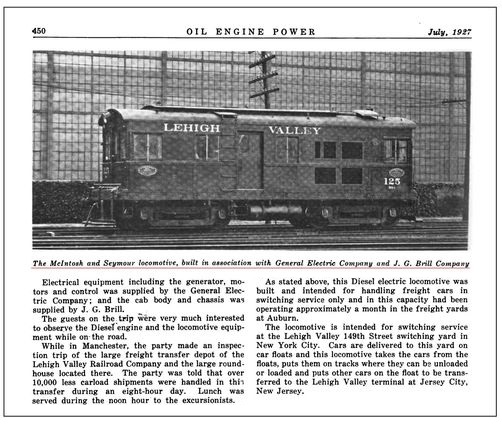
Sam Berliner's website pertaining to Boxcab Locomotives reflect that Brill constructed a boxcab locomotive with a McIntosh & Seymour diesel engine, but gives a 1927 build date as well.
Referencing "The Second Diesel Spotter's Guide" by Jerry A. Pinkepank, 1973; states on page Misc-358:
J. G. Brill Copmany
In 1927, the Lehigh Valley Railroad ordered a boxcab B-B switcher from J. G. Brill Company, the carbuilding concern which had supplied the LV with numerous gas-electric cars. A 9½ x 10½ 6-cylinder, 4-cycle, 700 r.p.m McIntosh & Seymour diesel engine was furnished for this unit, along with GE electrical equipment. The locomotive became LV 101 and apparently was not delivered until 1931.
A Wikipedia article on the "ALCo300" locomotive citing this same "The Second Diesel Spotter's Guide" ; and "The American Locomotive Company: A Centennial Remembrance" chapter VI, subchapter "ALCO's First Production Diesels" by Richard Steinbrenner: notes the following:
"A McIntosh and Seymour Box cab Lehigh Valley #125 was rebuilt with an ALCO 330 engine in 1931 and then renumbered Lehigh Valley #101"
The Pearce / Heiss article states Lehigh Valley renumbered this locomotive to #101 in 1938.
.
SW1 - unknown #
Seen in the Tim Darnell photo below, is a Lehigh Valley ElectroMotive Division (General Motors) model SW1. The image is too grainy to make out the road number.
.
|
|
| .
. |
|
|
| .
. |
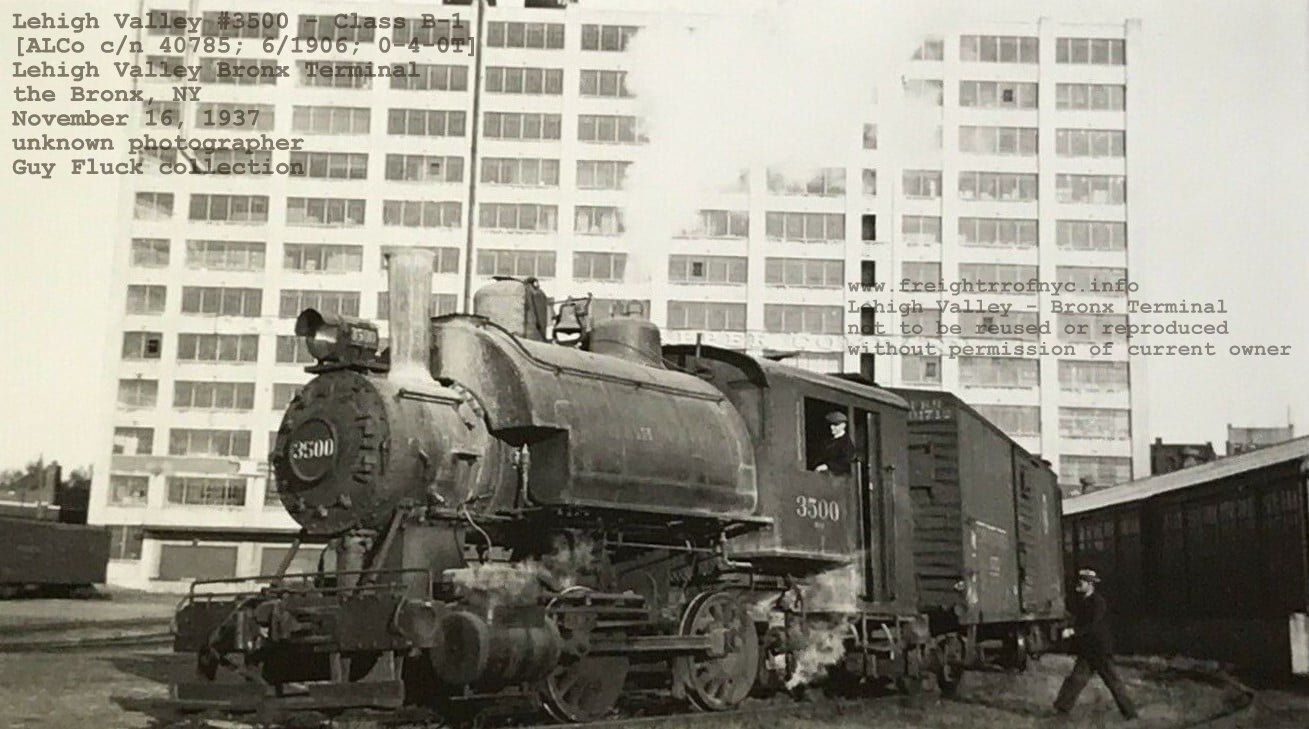 |
| .
. |
|
|
| .
. |
 unknown magazine |
| .
. |
|
|
| .
. |
|
|
| .
. |
|
|
| .
. |
|
|
| .
. |
|
|
| .
. |
|
|
| .
. |
|
|
| .
. |
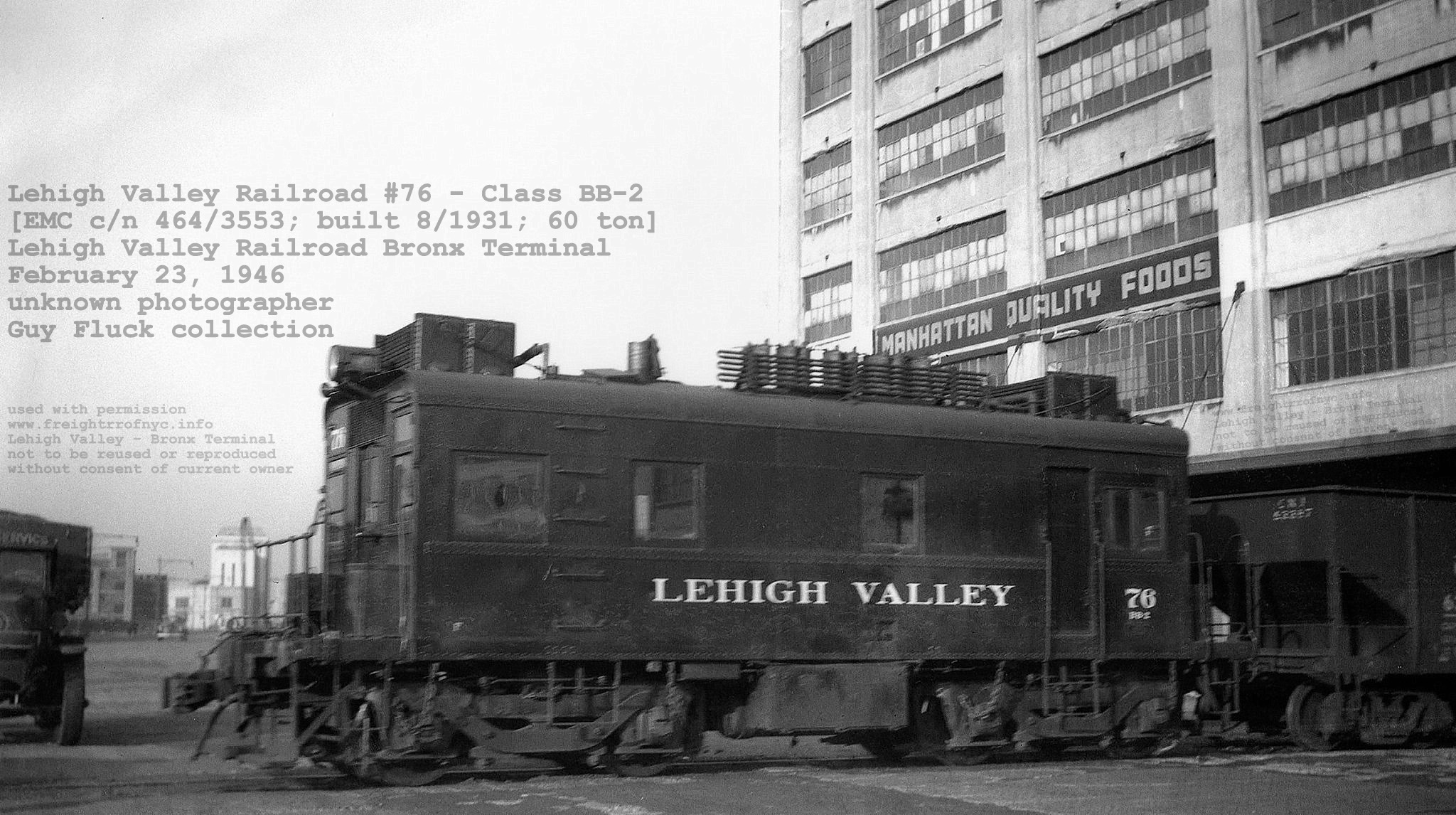 February 23, 1946 unknown photographer Guy Fluck collection added 13 April 2021 |
| .
. |
|
|
| .
. |
|
|
| .
. |
|
|
| .
. |
|
|
..
..
Bronx Terminal (LV) Locomotive
Roster
| original number / renumber |
builder | c/n | build date |
gauge |
wheel arrangement |
wheel dia |
model | cylinders |
acquired |
disposition |
notes | ref |
| #3500 | ALCo | 40785 | 6/1906 | std. | 0-4-0T | 48" | 16" x 24" | new | scrapped 8/1939 | [1] | ||
| #100 | A/GE/IR | 65981 / 9683 |
1/1926 | std. | B-B | 60 ton | new | unconfirmed if used at Bronx Terminal | ||||
| #125 / #101 | Brill - GE | 22343 | 1927 (4/1926?) |
std. | B-B | 73 Ton Boxcab | new | retired 1957 | renumbered 1938 300 hp M&S diesel engine |
|||
| #110 / #50 | Mack | 173001 | 12/1929 | std. | C | AY | new | scrapped 11/1946 | renumbered 1938 45T - Mack 6 cyl (3) gas / electric 405hp |
[10] | ||
| #111 / #51 | Mack | 173002 | 12/1929 | std. | C | AY | new | scrapped 11/1946 | renumbered 1938 45T - Mack 6 cyl (3) gas / electric 405hp |
|||
| #115 / #75 | EMC | 463 / 3554 |
8/1931 | std. | B-B | 38" | 60 ton | new | retired 1953 | EMC Model 60 - 400 hp Winton Engine Type 148 |
[a] | |
| #116 / #76 | EMC | 464 / 3553 |
8/1931 | std. | B-B | 38" | 60 ton | new | retired post 1955 | EMC Model 60 - 400 hp Winton Engine Type 148 renumbered to 76 in 1940 |
[a] | |
| #105 | ALCo | 68607 | 7/8/1932 | std. | B-B | HH600 | used 12/24/1932 |
scrapped 1963 | ex-ALCO demonstrator #601 | [1] | ||
| #109 | EMD | 1939 | std. | B-B | SW1 | new | ||||||
| #115 (2nd) / #101 | EMD | 1939 | std. | B-B | SW1 | new |
Locomotive Footnotes:
| The following information is courtesy
of Sam Berliner's website on EMC / EMD Boxcab locomotive |
||
| [a] | length: height: width: wheel diameter: truck wheelbase: |
40' 2¼" 15' ½" 10' 2" 38" 7' 6" 20' 10" between truck centers 8' 10" from truck centers to pulling faces |
| Mechanicals were built by EMC, and the carbody was constructed by Bethlehem Steel in 1930. Both units were delievered to Lehigh Valley in August 1931. |
||
.
Being a Lehigh Valley Railroad operation, the Bronx Terminal would have been serviced by Lehigh Valley Railroad tugboats, carfloats and lighters.
Charles Gerow, a New York Harbor Pilot (retired) based out of Sandy Hook, offered this explanation:
"the [lower] tugs were used NOT to avoid impeding road traffic, but to avoid being hung up by an obstinant draw tender, particularly if you had a fair tidal current pushing you."
This explanation makes good sense too as it would not be well off for the tug crew (or the bridge tender!) to hit the drawbridge.
The following image shows the easily recognizable differences between a "Harlem River" tugboat (on left) which could navigate the Harlem River without requiring bridges to open, as opposed to a standard profile railroad tugboat (on right) which could not:

.
.
It should also be noted that railroad terminals located along the Harlem River were imposed with physical restriction on the transport of carfloats. One must consider the narrow width of the channels between the swingbridge center island fender and end abutments. Therefore any tugboats transporting carfloats to any of the terminals located in the Bronx, would have to transport those carfloats singly.
According to Ralph Heiss, the Lehigh Valley Railroad did indeed have specific tugboats assigned to the serve of the Bronx Terminal, and are listed below. Disposition information on the "Cornell" and "Lehigh" has been generously furnished by Paul Strubeck.
|
|
||||||||||||||||||||||||||||||||||||||||||||||||||||||||||||||||||||||||||||||||||||||||||||||||||||||||||||||||||||||||||||||||||||||||||||||||||||||||||||||||||||||||||||||||||||||||||||||||
Tugboat Footnotes:
| [a] |
Main Engine: |
GM Cleveland 16-278a Rated at 1800 HP 1200kw 525VDC(2) Detroit Diesel 3-71 30kw 120VDC each B20 Biodiesel/MDO 18,000 Gallons 2,800 Gallons |
.
.
|
|
| .
. |
|
|
| . |
|
|
| . |
|
|
| . |
|
|
| . |
|
|
| . |
|
|
| . |
|
|
| . |
|
|
|
. |
|
|
|
. |
|
|
|
. |
|
|
| . |
|
|
|
. |
|
|
| . |
|
|
.
Like what you see? Suggestions?
Comments?